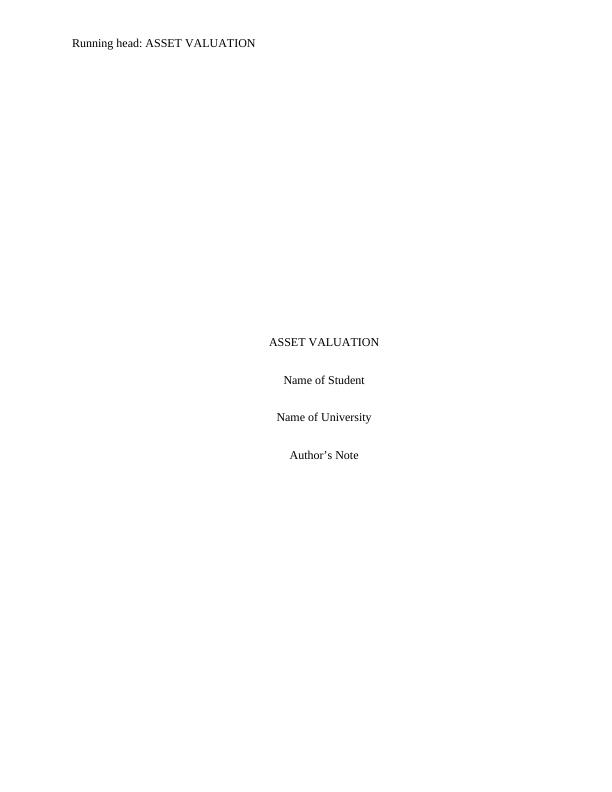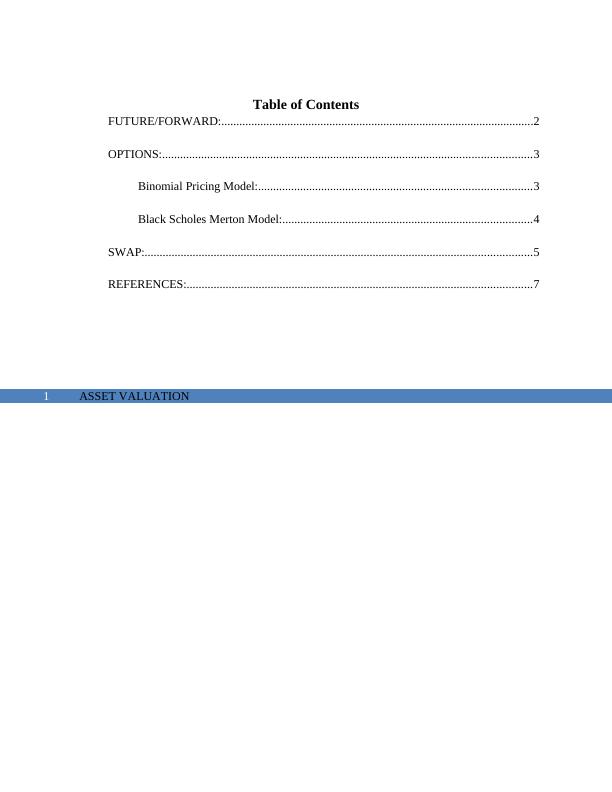THE ASSET VALUATION
Added on 2022-08-29
8 Pages1410 Words21 Views
Running head: ASSET VALUATION
ASSET VALUATION
Name of Student
Name of University
Author’s Note
ASSET VALUATION
Name of Student
Name of University
Author’s Note

ASSET VALUATION1
Table of Contents
FUTURE/FORWARD:........................................................................................................2
OPTIONS:...........................................................................................................................3
Binomial Pricing Model:...........................................................................................3
Black Scholes Merton Model:...................................................................................4
SWAP:.................................................................................................................................5
REFERENCES:...................................................................................................................7
Table of Contents
FUTURE/FORWARD:........................................................................................................2
OPTIONS:...........................................................................................................................3
Binomial Pricing Model:...........................................................................................3
Black Scholes Merton Model:...................................................................................4
SWAP:.................................................................................................................................5
REFERENCES:...................................................................................................................7

ASSET VALUATION2
FUTURE/FORWARD:
Future is an integral part of any derivative contracts. It enables the parties to make
transactions of any asset at a prearranged price and date. The future contract ensures that
purchaser must purchase and seller must sale irrespective of the market price of that asset. The
transactions need to be done on the pre-determined date. There are several ranges of products
like tangible products like gold or silver and intangible products like financial instruments.
Future contracts includes the details the quantity of the products that needs to be transacted and
the price at which it will be transacted. Future contracts also include the date on which the
transaction will be done.
The main principles of the future contracts are that the contracts expired on the pre-set
date in the future. This date is known as expiration date. Before this date the future positions can
be selected by the entities involved. The entities need not to wait for the expiration date; they can
perform the transactions before the date. This type of strategy is very common among the short-
term traders and speculators (Brigo, Capponi and Pallavicini 2014).
Cost of Carry can be defined as the difference between the costs of the asset that is
involved in the future contracts and the return that generated from that contracts. Cash and carry
is a type of arbitrage that is used in the derivate market. Cash and carry transaction is considered
as the trade where the price of the commodity in future contract is above than its market price.
During the time of shortages the holder of any consumption asset can gain convenience yield
from the contract because the entity can sell that product at much higher price. When the investor
expects that the price of the asset will rise over time then contango occurs. In this situation the
future prices of that commodity will be higher than its spot price. Backwardation is the opposite
FUTURE/FORWARD:
Future is an integral part of any derivative contracts. It enables the parties to make
transactions of any asset at a prearranged price and date. The future contract ensures that
purchaser must purchase and seller must sale irrespective of the market price of that asset. The
transactions need to be done on the pre-determined date. There are several ranges of products
like tangible products like gold or silver and intangible products like financial instruments.
Future contracts includes the details the quantity of the products that needs to be transacted and
the price at which it will be transacted. Future contracts also include the date on which the
transaction will be done.
The main principles of the future contracts are that the contracts expired on the pre-set
date in the future. This date is known as expiration date. Before this date the future positions can
be selected by the entities involved. The entities need not to wait for the expiration date; they can
perform the transactions before the date. This type of strategy is very common among the short-
term traders and speculators (Brigo, Capponi and Pallavicini 2014).
Cost of Carry can be defined as the difference between the costs of the asset that is
involved in the future contracts and the return that generated from that contracts. Cash and carry
is a type of arbitrage that is used in the derivate market. Cash and carry transaction is considered
as the trade where the price of the commodity in future contract is above than its market price.
During the time of shortages the holder of any consumption asset can gain convenience yield
from the contract because the entity can sell that product at much higher price. When the investor
expects that the price of the asset will rise over time then contango occurs. In this situation the
future prices of that commodity will be higher than its spot price. Backwardation is the opposite

End of preview
Want to access all the pages? Upload your documents or become a member.
Related Documents
The current market price of that assetlg...
|8
|1475
|17
Assignment on Spot Market(All About)lg...
|6
|1953
|25
Future & Optionslg...
|16
|3819
|37
Derivative and Its Four Typeslg...
|31
|5207
|301
MONEY AND CAPITAL MARKET ANALYSISlg...
|12
|803
|20
MONEY AND CAPITAL MARKET ANALYSISlg...
|5
|842
|17